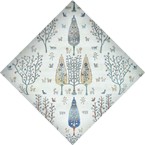What do you do when you want the comfort and quality of a hand-knotted rug (which, unfortunately, does not exist in machine-made rugs) and the fashionable style of a modern rug? In this case, Nepal and Tibet hand-knotted rugs would be an appropriate choice for you, since they have modern design and high quality material, usually a combination of silk and wool.
Evidence unearthed from the Caro Historical Site Fang, in Tibet, shows the existence of weaving of a fabric with wild animal hair dating back to 923 AD. By the time Tri Tsepa was in power, who was the great grand – child of the Tibetan King, Langtarma, the people in the region of Tingri and Saga were already weaving carpets in a technique called “Lhaewu”, or “Glide” weaving. That must have been the origin of carpet weaving in Tibet. Nyachi of Shigaste region was the center of carpet weaving during the 11th Century AD. Now this region is known as the Wangden District.
DESIGN
Hand knotted Tibetan carpets and rugs are made using an overlapped interlink buckle or an interlink knot technique. This technique enhances the efficiency of the weavers and makes the process of carpet weaving less labor intensive too. The result is a lustrous and velvet like surface, which makes these carpets look and feel luxurious. The designs are simple geometric motifs like the checkerboard and “gau” or amulet design. These motifs are popular. Medallion designs, dragon motifs, phoenix designs, floral motifs, clouds, and other designs borrowed from China are commonly found in Tibetan carpets and rugs. Tibetan Tiger Rugs are also very popular. Tiger rugs are considered special due to their religious inspiration. They were gifted to Lamas in the monasteries.
MATERIAL
Tibetan weavers use sheep wool called “changpel” to weave their carpets. They also use silk fibers dyed in natural colors. This is why hand knotted Tibetan carpets have a very high luster and soft feel. Soft earth colors of beige, camel, soft red, blue and brown are commonly seen in these carpets.
(8'0" x 10'0") Tibetan Indo-Tibetan
SKU 100-22646
(14'9" x 16'5") Tibetan Indo-Tibetan
SKU 400-17301























Be the first to know about new designs and
exclusive offers, and get up to
10% OFF
your first purchase

Rugman.com since 1998 | The first and oldest online rug store
You can unsubscribe with a single click. We value your privacy; click here for more info.

You have one more step to join
Rugman Insider Club.
A coupon code will be emailed to you.
Please check your email and just
click the green “Confirm Subscription” button.

